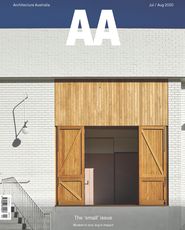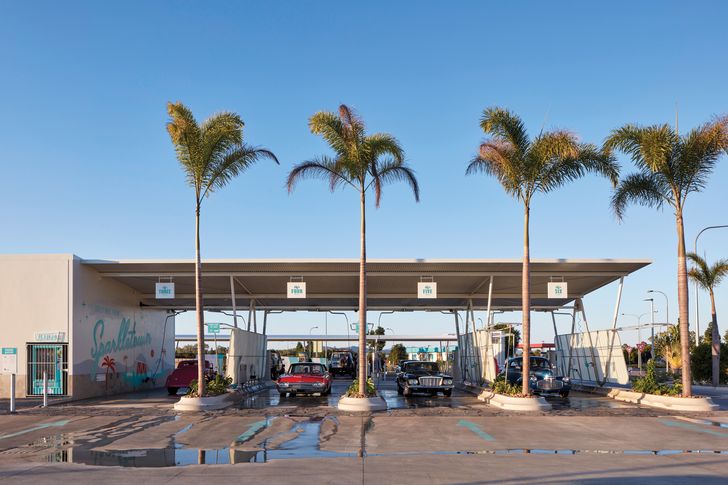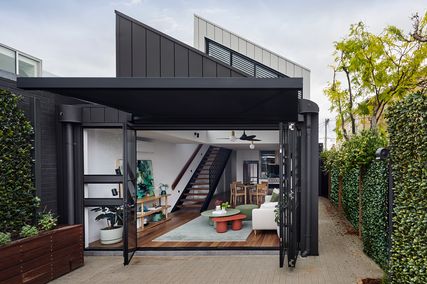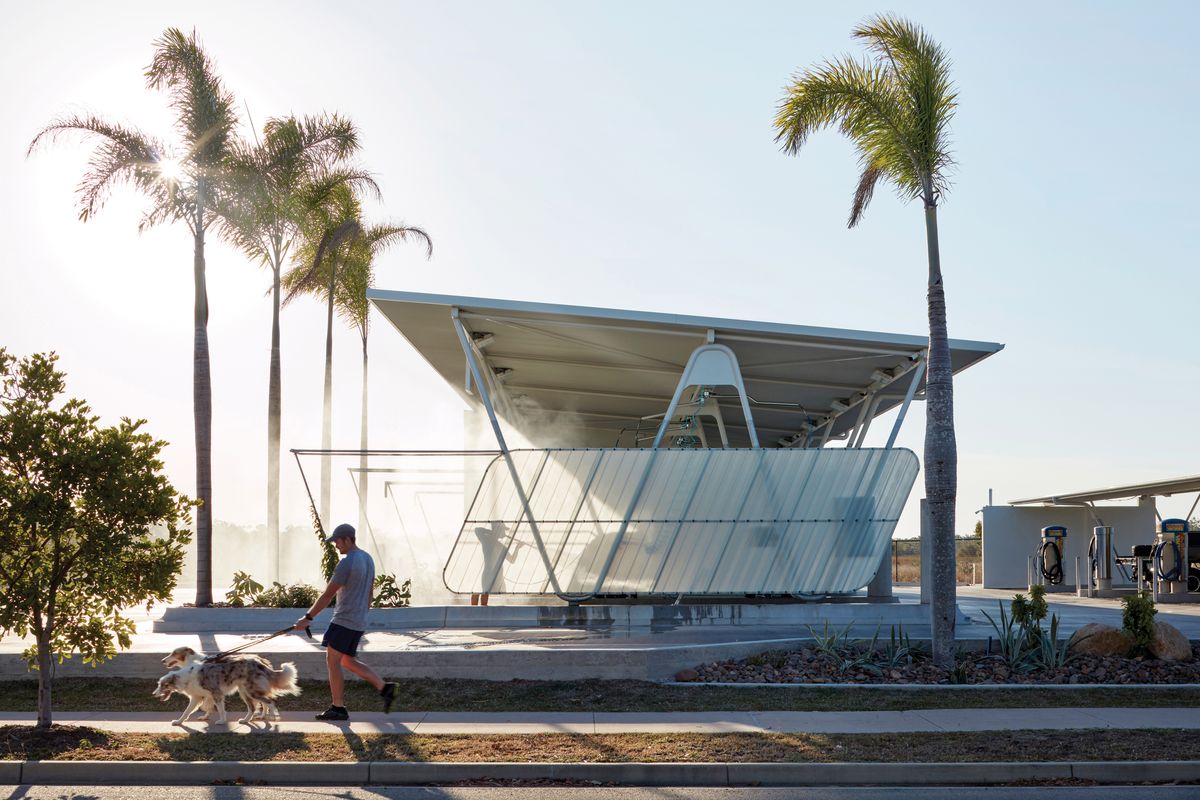In regional towns and cities across Australia, the car reigns supreme. The time-honoured tradition of “chucking a blockie” or “hacking a mainy” (driving around the inner city or up and down the main street) remains a favourite pastime. It is a well-worn adage that “if you can’t park out front, don’t bother going.” But while the car is central to regional life, it is not often a catalyst for good design. Usually, the pragmatics of parking and car servicing dominate new development, as big-box stores in large sheds stamped with universalized corporate branding become the hallmark of growing settlements. Townsville’s Northshore Car Wash offers a delightful alternative, overlaying the essential components of a small utilitarian service building with an expressive armature that endeavours to create a sense of place and identity.
Architecture practice Twohill and James worked closely with the client, property developer Rick McLaren of Twenty Six Street, graphic designer Adam Gower of ACG Creative and landscape architect Luke Jones of Larc Collective to develop the design and branding of a prototype for a new chain of car-wash depots. McLaren had been researching the carwash industry for some time and had recognized its potential within an expanding service economy. The team was interested in how the carwash could be elevated beyond base-line pragmatics and developed a design that promoted both user experience and product branding. Driven by a shared desire to design interesting and memorable places, they took on the challenge to create a carwash that could “make a chore fun” and transform that chore into a regular and habitual social activity.
In its use of geometric shapes, expressed structure and sloping roofs, the design references the architecture of 1950s Southern California.
Image: Christopher Frederick Jones
Northshore Car Wash is located on the edge of a new suburban development, with a Bunnings across the road and a McDonalds up the street. Although much smaller in scale than its neighbours, the carwash seeks to establish itself as a landmark in an as-yet-unmade suburban context. It provides a hub for washing cars, boats, caravans and pets, with ancillary spaces that can accommodate local fundraising activities. According to McLaren, the design team aimed to make a place that “consciously evokes nostalgia for a time when the family car was a major asset, when cars were celebrated and [when] we took pride in taking care of them.”
Stylistically, the building references the car- oriented architecture of Southern California in the 1950s – motels, drive-in restaurants and movie theatres, service stations and carwashes – which was dubbed “Googie architecture” by architectural critic Douglas Haskell. Named (disparagingly, at first) after a coffee shop designed by John Lautner in 1949, Googie architecture was also known as Populuxe, a portmanteau of popular and luxury. It emerged from the 1930s Streamline Moderne movement and celebrated emerging postwar technological developments, from increased private car ownership to space travel. Merging branding and architecture, Googie was characterized by identifiable geometric shapes, expressed structure, acute angles, sloping roofs and a particular graphic style that transformed buildings into signposts and billboards. Buildings were designed to catch the attention of drivers and to allow businesses to be identifiable from the road.
The fittings — all customized — sit on a profiled concrete plinth that also incorporates a garden bed, which is welcome in Townsville’s parched dry-season climate.
Image: Christopher Frederick Jones
The Northshore Car Wash knowingly engages in these traditions through its architecture, its graphics and its cheery “Welcome to Sparkletown” slogan, which provides a welcome alternative to Townsville’s popular dry-season epithet, Brownsville. On a practical level, the design team worked with car- and pet-wash equipment subcontractors to analyze operations and customer flow and develop ideas for utilizing standard equipment, but rethinking its installation. Research revealed that more women than men wash cars and this reinforced the desire to design spaces that created openness and translucency that would promote a sense of safety. The utilitarian space of the carwash, which is usually more like a service bay in a mechanics workshop, was reconfigured as a light, airy and dynamic place that fostered interaction.
Two parallel skillion roof structures house the wash and vacuum bays, while a dog wash – the “pooch pit” – is contained in a third pavilion. W-shaped frames support polycarbonate screens and also carry the water down from an overhead supply line. The translucent screens establish a spatially dynamic environment and amplify the silhouettes of people inside the wash bays. All of the fittings are customized, from the holders for spray guns and foaming brushes to the clips for hanging rubber mats on and the bollards that house the “carwash manager” control. All of these items sit on a profiled concrete plinth that also incorporates a garden bed. A trellis extends each bay, on which climbing plants take advantage of the water spray in this frequently arid environment. Landscaping is integral to the design, creating a sense of character and reinforcing mid-century design references. Palm trees along the road and at the entry to each bay signal the idea of a tropical paradise or oasis. Porphyry-crazy paving breaks up the expansive concrete concourse, expressing pedestrian zones across the carwash bays and the hangout area near the pooch pit.
The W-shaped fames that support the screens are also used to transport water from an overhead supply line.
Image: Christopher Frederick Jones
As a working prototype, this project has provided an opportunity to reconceptualize a rudimentary building type while also helping to develop the design of the business profile. Small but detailed design elements are carefully considered in order to knit together a bigger narrative and broaden the consistency of experience. Additional infrastructure has been laid for future development, allowing for the addition of a kiosk near the dog wash that could house a barbecue pavilion or a takeaway coffee shop. The business objective of establishing the carwash as a site for social activity is supported by a curated Spotify playlist, while young locals gathering here have discovered how to manipulate the tri-colour wax to create different patterns on their cars. The photographs they upload to social media are expanding the communal culture of the carwash.
This small project demonstrates the potential for even the most pragmatic infrastructure to be overlaid with stronger aspirational ideals. It takes its place within a genre of small-scale, well-designed infrastructure, from the Bus: Stop project in Austria to the practical yet whimsical structures erected along the Norwegian Scenic Routes, as well as the series of excellent public toilet blocks across Australia. As Andy Fergus suggested in his review of the latter, “this pattern of public agency investment in the design quality of such essential small public works offers an opportunity to promote civic dignity and architectural value in an unexpected typology.” 1
While an enduring pragmatism generally rules in the regions, increasingly, good design is playing a part in the everyday as local councils across Australia invest in urban infrastructure. From Barcaldine to Maitland and from Barwon Heads to Noosa, small-scale urban architecture is being commissioned by local councils, transforming the character of places by small, but important, increments. In Townsville, the beach boardwalk at The Strand, Cox Rayner’s Thuringowa Riverway Arts Centre and Lagoons (2002–08) and Flinders Street Revitalization (2008–11), have transformed the urban and civic experience. Many of these projects are modest in size but generous in ambition, and each is underpinned by a belief that carefully considered, well-made civic buildings – even at the smallest of scales – assure people in the regions that they and their environments are as important as places in the city.
Northshore Car Wash is an example of how private industry is taking up the baton offered by local councils to commission well-designed urban infrastructure. It is perhaps a minor triumph that such a small and utilitarian commercial project has come onto the architectural radar, demonstrating the value of good design in even the most prosaic environment.
1. Andy Fergus, “Designer public dunnies: Civic dignity in small public architecture,” ArchitectureAU website, 23 August 2017, architectureau.com/articles/designer-public-dunnies-civic-dignity-in-small-public-works/ (accessed 17 April 2020).
Credits
- Project
- Northshore Car Wash
- Architect
- Twohill and James
Brisbane, Qld, Australia
- Project Team
- David Twohill, Emma James, Hannah Byrne, Matthew Hawke
- Consultants
-
Branding and signage
ACG Creative
Civil and structural engineer Steve McKenzie Consultant Engineer
Electrical and hydraulic engineer WSP
Landscape architect Larc Collective
Technical equipment TEAM Car Wash Services
- Aboriginal Nation
- Built on the land of the Bindal and Wulgurukaba peoples.
- Site Details
-
Location
Townsville,
Qld,
Australia
Site type Suburban
Site area 2020 m2
Building area 510 m2
- Project Details
-
Status
Built
Completion date 2019
Category Commercial
Type Small projects
Source

Project
Published online: 17 Nov 2020
Words:
Helen Norrie
Images:
Christopher Frederick Jones
Issue
Architecture Australia, July 2020
























